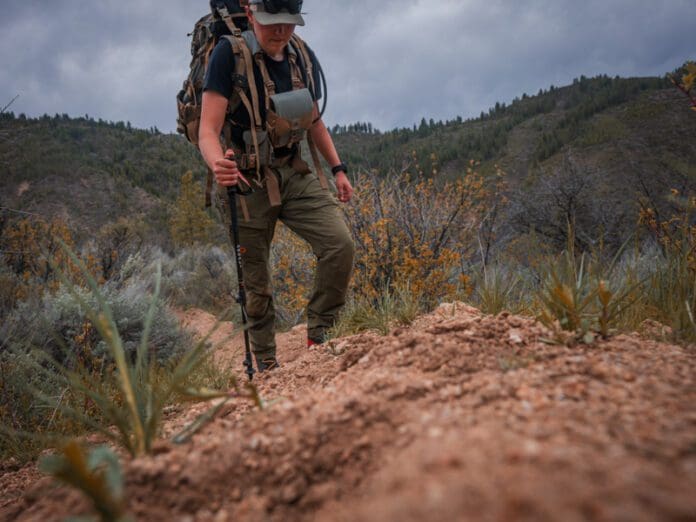Carrying a set of trekking poles into the backcountry has become fairly standard, and for good reason. The obvious reason to carry a pair is to assist with balance while traversing terrain, often with heavy loads. But they also can be useful for pitching tarps, a resting point to steady your binoculars or rifle, and tent companies are even designing shelters to be pitched with trekking poles for weight savings. When the good folks at Argali first gave me a set of their new Carbon X trekking poles with a couple of accessory attachments and explained the idea behind them, I was excited to get them in the field.
The Run Down
The Carbon X (Link) and Guide X (Link) trekking poles are a new release for 2023 from Argali. They are designed with purpose for the western hunter.
The Carbon X poles are 15 ounces for the pair, while the Guide X set comes in at 17.5 ounces. The Carbon X is built with a semi-thick wall of carbon fiber.
The Guide X is a hybrid build of carbon fiber on the upper portion of the pole, with the two leg extensions being made of 7075 aluminum. With the Guide X having a hybrid of materials, that is where you see the money savings of about $24 and a weight penalty of 2.5 ounces over the Carbon X.

Using the Carbon X
I started using the Carbon X poles about a year ago, and I really have no complaints about the poles. Argali decided to go with flick lock (also known as a lever lock) adjustments which I personally prefer over the option of twist locks.
The flick locks are low profile and have an inset to them, so they fold almost flush with the pole, eliminating a snag point while pulling out of a pack which is often the point of contention with a flick lock. I never felt like the locks hung up on any strap or material when I was pulling in and out of my pack. The grips are made from an EVA foam which was comfortable to grip and also seemed to be durable.

The Accessories
The accessories built for the trekking poles are what really separate these poles from the competition. On top of the grip on each pole, there is a rubber tab that covers 1/4×20 threads. This is where you can screw on the QuickShot and X3 adapters. The QuickShot adapter is a simple “v” rest that you can shoot from. I never got into a situation where I needed to use the QuickShot adapter, but there’s no denying its usefulness.
I did use the X3 adapter a lot, and to me, it’s a genius yet simple innovation. The X3 adapter is an aluminum piece with threading on each end, made to screw your trekking poles together to make one long pole. This is useful for pitching single pole shelters, like the Argali Absaroka 4p, which Jaden Bales previously reviewed, or just getting more height from your poles to pitch a tarp as we did in Alaska.

Conclusion
I used these poles all of last year in Alaska, Idaho, Wyoming, and Montana. I had to adjust the tension on one of the flick locks a couple of times to add friction while locked, but other than that, I had no issues with the poles.
The wrist straps were comfortable and easily adjustable. They’re also easily removable if you prefer. They are compact when collapsed at 25”, making them fit within your backpack frame size. They come with rubber feet attached with mini baskets in the box that can be used if you wish. I personally took the rubber feet off so I could stick the trekking poles vertically in the ground instead of laying them down. However, the rubber feet will be quieter around rocks.

If you’re in the market for a new set of poles, give the Carbon X or Guide X from Argali a look.
Ask Jordan or Brad Brooks questions here.
You might also like these gear reviews.



















